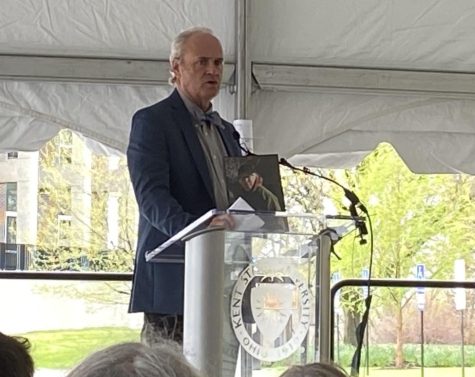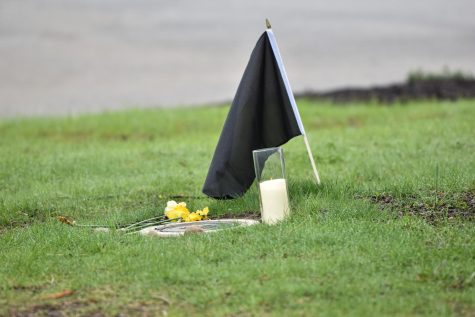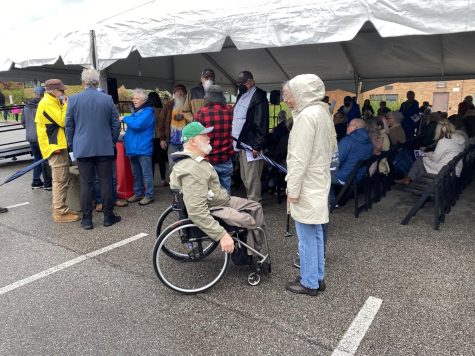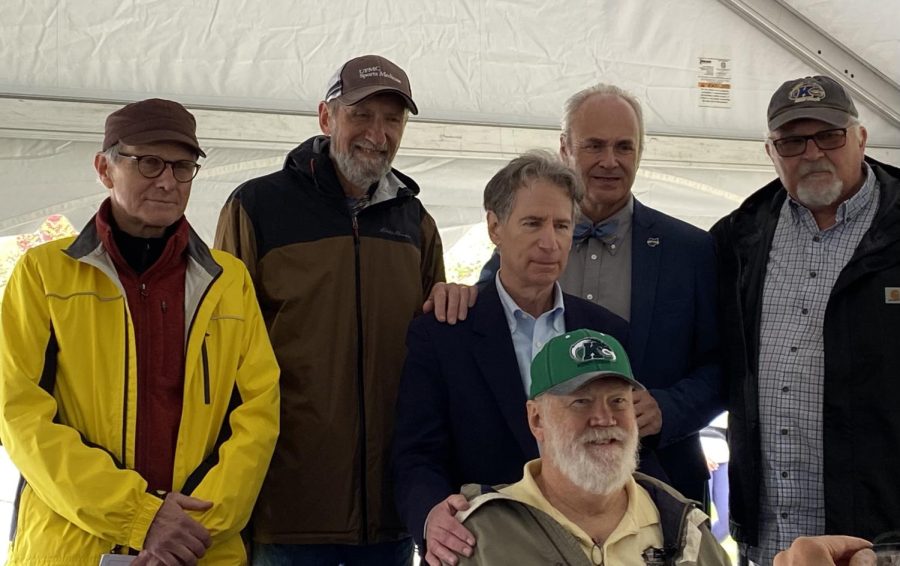Nine markers dedicated to commemorate May 4 wounded
Todd Diacon poses with five of the nine wounded survivors from the May 4 shooting at a dedication ceremony for markers honoring the wounded. (L-R) Donald Scott Mackenzie, John Cleary, Thomas Grace, Todd Diacon, Joseph Lewis Bottom: Dean Kahler
May 4, 2022
Nine former students, who were wounded on May 4, 1970, were honored during a dedication ceremony for markers placed at each spot near Taylor Hall where they were shot 52 years ago.
Four other students were killed, including Allison Krause, Jeffrey Miller, William Schroeder and Sandra Scheuer when members of the Ohio National Guard opened fire on protesters on the Kent State campus.
Each marker features the name of the person wounded, along with the distance in feet they were located from the National Guard at the time of the shootings.
Five of the nine survivors attended the ceremony, including Dean Kahler, Donald Scott Mackenzie, Joseph Lewis, Thomas Grace and John Cleary. Douglas Wrentmore did not attend and Alan Canfora, James Russell and Robert Stamps are deceased.
“Having a visual reminder of where those students were when they were shot is so powerful,” President Todd Diacon said. “And particularly when you look at Scott Mackenzie’s marker, which is the farthest one away, you just realize how quickly violence gets out of control.”

The markers are in addition to the memorials in the Prentice Hall parking lot where the four students died.
“I always talk about the lessons to learn from May 4, which has to do with the dangers of polarization and polarized discourse,” Diacon said. “So it means a lot to me to have the wounded students here today and to have these markers in place, because it’s such a powerful visual representation of all of that.”
Planning for the markers began two years before the 50th anniversary, with the idea of having them in place for that commemoration, said Michael Bruder, former university architect.
Rodney Flauhaus, May 4 commemoration project manager, and Alan Canfora had the idea since 1983 of having a commemoration for each student wounded, Flauhaus said.
For the victims and families of the victims, the markers serve as a reminder of what happened.
“It means the fact that where I was shot, will always be there, time eternal,” Kahler said. “And that when people come here, they can stand where I was shot and look up the hill, and see that I was 260 some-odd feet away from the National Guard… and that I was no threat.”

Roseann “Chic” Canfora is a May 4 witness and professional in residence in the School of Media and Journalism at Kent State. She also works with the President’s Office and the May 4 Presidential Advisory Committee to oversee the university’s May 4 commemoration plans. She said the marker is like a tombstone for her since her brother Alan died.
“I know my brother and Rod Flauhaus and some of the other wounded students had advocated to also mark where the wounded students fell so that people throughout history would see how far those bullets had to travel to reach their targets,” Canfora said.
A couple of years ago, Diacon said, Alan Canfora and Grace toured the campus to look at the trees near the site of the shootings on Blanket Hill near Taylor Hall, to figure out which ones were planted after May 4 and which were there during.
“I heard (Alan Canfora) say ‘I love this tree,’ he said in a loud voice,” Diacon said. “He said ‘this tree saved my life.’ And ever since then I’ve loved that tree as well.”
Even those who were not present 52 years ago came to commemorate the markers. Dawn Grattino and Rainbow Bear were previously a part of the task force.
“I love that the memorial markers are right in the middle of the parking lot where they’re in the way and everybody’s got to deal with them every day who uses the space,” Grattino said.
Rainbow Bear started coming every year and became friends with Jim Chonjnack, who was present on May 4, 1970.
Chonjnack was not wounded that day but was behind Kahler.
“I was in the crowd on the hillside singing Beatle songs and then I peeled off,” Chonjnack said. “Most of the people came over here, I went into the field which kept me a little bit safe.”

To Kahler, the markers show the “fabricated lie” that was told all these years.
“Everybody has been recognized where they were and shows that we were no threat. Because if they were a threat and there was a horde of students ready to overrun them, there would have been more than 13 people shot.”
Some of those who were involved in May 4 were not protesting or involved in the event.
“If you’re outside in a group of more than four people, the authorities can consider you part of the protests,” Kahler said. “So I was standing amongst a crowd of a couple thousand people. I wasn’t throwing stones, I wasn’t doing violence. I was there to learn if I could get direction because there was no direction that whole weekend about what our rights were, what our responsibilities were, what we could do, what we couldn’t do.”
Alexandra Golden is an assigning editor. Contact her at [email protected].












